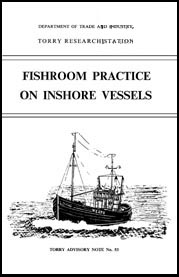Contents Index

Accompanying Notes
Table of Contents
DEPARTMENT OF TRADE AND INDUSTRY
TORRY RESEARCH STATION
TORRY ADVISORY NOTE No. 53
Crown copyright material is reproduced with the permission of the Controller of Her Majesty's Stationery Office.
This electronic document has been scanned using optical character recognition (OCR) software and careful manual recorrection. Even if the quality of digitalisation is high, the FAO declines all responsibility for any discrepancies that may exist between the present document and its original printed version.
Advises on the design, construction and operation of fshrooms on inshore vessels less than 25 metres. Gives guidance on boxing and icing practice for chilling the catch, and on the uses of insulation and mechanical refrigeration. Read in conjunction with Note 11. Notes 4, 7, 15, 21 and 32 are also relevant.
To meet current hygiene requirements, boxing in plastic boxes of nest/stack and stack only types, of varying dimensions and nominal capacities, is the norm. The 70 litre plastic box with a nominal capacity of 45 kg fish plus ice is widely used; a minimum of 15 kg ice would be recommended with this quantity of fish. Other box sizes are also in use. The capacity of the unit box should not be used as an accurate indicator of the quantity of fish actually present in the box on landing. It has been common practice to overfill these plastic boxes by up to 40% compared with the nominal capacity. Unfortunately, overfilling of boxes with fish, and the consequent loss of weight, yield and quality of the fish, compared with correct boxing practice, remains a problem for the industry to resolve.
(FAO in partnership with Support unit for International Fisheries and Aquatic Research, SIFAR, 2001).
Introduction
The use of ice
Fishroom construction
Summary
Contents Index